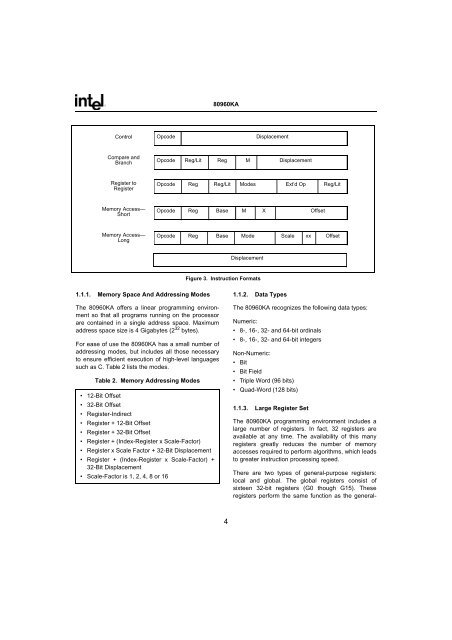80960KA EMBEDDED 32-BIT MICROPROCESSOR - Datasheet ...
80960KA EMBEDDED 32-BIT MICROPROCESSOR - Datasheet ...
80960KA EMBEDDED 32-BIT MICROPROCESSOR - Datasheet ...
You also want an ePaper? Increase the reach of your titles
YUMPU automatically turns print PDFs into web optimized ePapers that Google loves.
<strong>80960KA</strong>ControlOpcodeDisplacementCompare andBranchOpcode Reg/Lit Reg M DisplacementRegister toRegisterOpcode Reg Reg/Lit Modes Ext’d Op Reg/LitMemory Access—ShortOpcode Reg Base M X OffsetMemory Access—LongOpcode Reg Base Mode Scale xx OffsetDisplacementFigure 3. Instruction Formats1.1.1. Memory Space And Addressing ModesThe <strong>80960KA</strong> offers a linear programming environmentso that all programs running on the processorare contained in a single address space. Maximumaddress space size is 4 Gigabytes (2 <strong>32</strong> bytes).For ease of use the <strong>80960KA</strong> has a small number ofaddressing modes, but includes all those necessaryto ensure efficient execution of high-level languagessuch as C. Table 2 lists the modes.Table 2. Memory Addressing Modes• 12-Bit Offset• <strong>32</strong>-Bit Offset• Register-Indirect• Register + 12-Bit Offset• Register + <strong>32</strong>-Bit Offset• Register + (Index-Register x Scale-Factor)• Register x Scale Factor + <strong>32</strong>-Bit Displacement• Register + (Index-Register x Scale-Factor) +<strong>32</strong>-Bit Displacement• Scale-Factor is 1, 2, 4, 8 or 161.1.2. Data TypesThe <strong>80960KA</strong> recognizes the following data types:Numeric:• 8-, 16-, <strong>32</strong>- and 64-bit ordinals• 8-, 16-, <strong>32</strong>- and 64-bit integersNon-Numeric:• Bit• Bit Field• Triple Word (96 bits)• Quad-Word (128 bits)1.1.3. Large Register SetThe <strong>80960KA</strong> programming environment includes alarge number of registers. In fact, <strong>32</strong> registers areavailable at any time. The availability of this manyregisters greatly reduces the number of memoryaccesses required to perform algorithms, which leadsto greater instruction processing speed.There are two types of general-purpose registers:local and global. The global registers consist ofsixteen <strong>32</strong>-bit registers (G0 though G15). Theseregisters perform the same function as the general-4

















